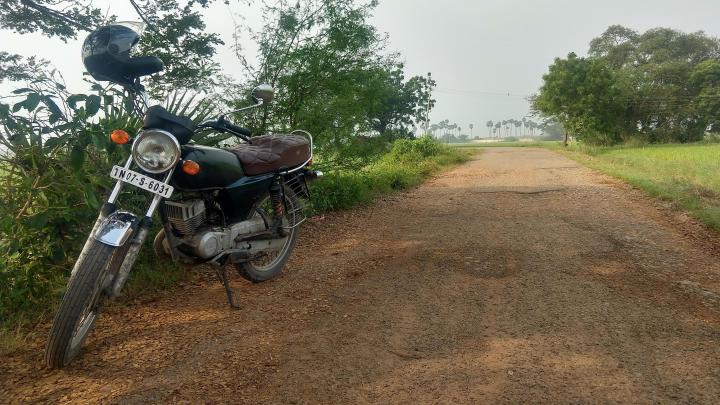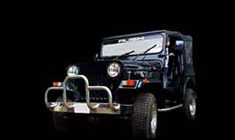News
Touring on a 20-year-old 2-stroke Suzuki Max 100: My experiences & tips
To this day, I've never had a second thought when it comes to getting onto my machine and simply doing a 100-kilometre run just like that, completely unplanned.
BHPian Abhyjith K.A recently shared this with other enthusiasts.
“Ring-Ding-Ding.” The sonorous orchestra that tugs the heartstrings of one too many. Two-strokes are addictive. That’s a fact. A fact that can be attested by yet again, one too many. But regardless of whether our loyal steed is powered by a heart that beats in two cycles or four, one thing is certain that all of us can agree on. Our machines are just like us; Dying to see the world. Dying to explore. Dying to live.
It's officially 2023. For years on end, most of us have lived through times being spoon-fed (Force-fed) on the “fact” that “electricity is the future”, it’s time to “Go Green”, and so on and so forth. Just like all spoon-fed children, I too would eventually turn into a rebellious teen. We’ve all been there once upon a time. “Ok, whatever”, stands my reply to most current trends regarding automotive propulsion, as I kick-start my 20-year-old two-stroke into life with the excited anticipation of the newest adventure about to unfold.

My pride & joy. Suzanna.
It’s been almost over a decade and a half since the last two-stroke road-going motorcycle rolled off the assembly line in India. Thus, whatever we’re left with is a highly endangered species. One that deserves to be protected. “Why?”, you ask? Take one for a ride and you’ll know. Experience speaks things words cannot.
And that is the reason I’m writing this thread on two-strokes. Not my first and certainly not my last. So, without further ado, let’s jump right into the topic at hand. And yes, it’s exactly all that the title says!
Let’s come back to one of my earlier points. “Our machines are just like us. Dying to see the world. Dying to explore. Dying to live.” All this leads to one very specific aspect of motoring. Touring. Exploring the world on your machine, in simple terms. These days, “Touring” in the context of motorcycles makes us think of many things. Chief among them being two-wheeled convoys, all loaded up with luggage, mostly thumping their way to Ladakh. Maybe even Adventure Bikes, soaking up the rough terrain, yet feeling heavy, but firm, planted, and reassuring at the same time. Or even long baggers, cruising on the highway at tick-over, doing triple-digit speeds. But all these images in the mind ignore one harsh truth.
Once upon a time, we never really had all these in our country.
There were exceptions of course, but on the whole, it was a very different place to what it is now, in that regard.
But with what we did have though, we certainly lived with. And even flourished. All the experienced seniors reading this will know exactly what I’m on about. Once upon a time, there was no pretension. Machines were machines and we used them for what they were truly capable of. That’s why “Two-stroke Touring” never did capture the attention as a novelty that it captures today. Because once upon a time, it was normal. It was normal to take your 100 to 140cc (Or any cc for that matter) two-stroke and traverse long distances on it. Miles munched with little to no gear, and little to no digital assistance, yet with so much meaning within.
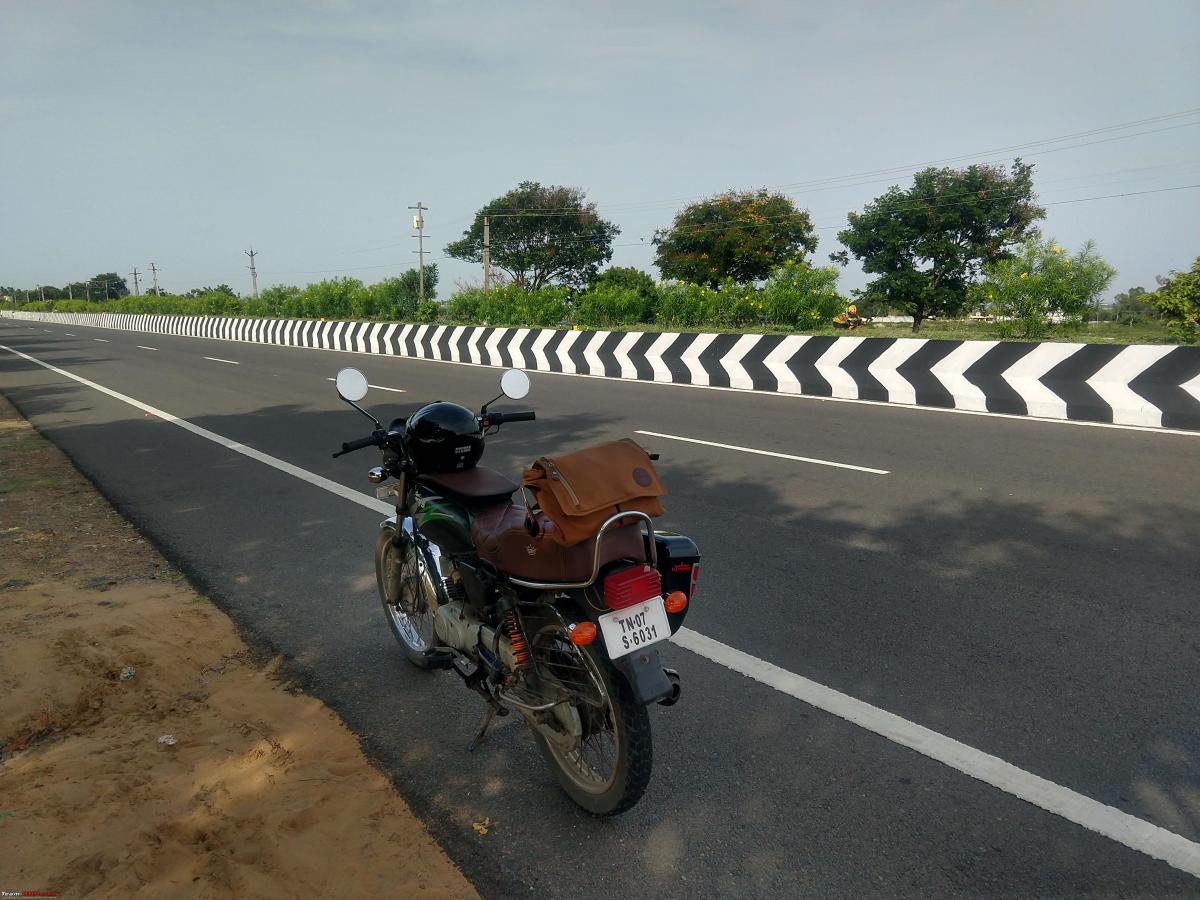
There are countless stories of our people on their two-stroke motorcycles that have been swept away by the waves of time and forgotten, never to properly resurface again. And that’s exactly why I’m writing this. It’s an ode to all those miles. The miles that are our past. On which, the present we live today is built upon.
So, when it comes to two-strokes, touring as a possibility is a one hundred percent yes. And those words are my own from my own young, brief, yet adequate experiences. My first motorcycle is a 2 stroke, and I couldn’t be proud enough of her. At the time of writing this article, I’ve racked in just about 7000 kilometres on her under my ownership since I got her earlier this year. And a lot of those kilometres were small tour kilometres. As I sit, writing this down, the time is 19:16. It’s the 28th of December, 2022. Just a couple of hours back, I had returned home after a 200 kilometre trip with my friends. Sure, this is nothing besides some proper long-distance tours, but it was more than enough for me to put my inspiration on paper for you, the enthusiast.
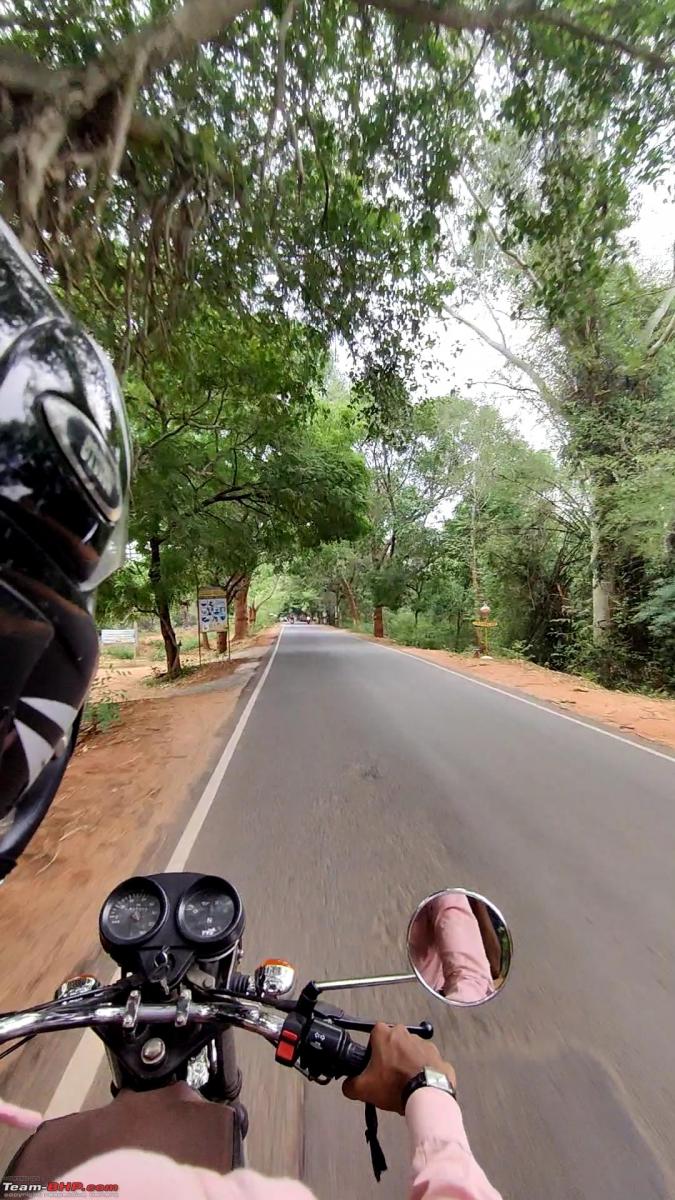
The two-stroke powerband is one so unique. It’s never truly linear, but always exciting. Right when you think it's gonna run out of puff is when it starts pulling even harder. Two-strokes love to be revved and deliver most of the smiles they can under higher revs. For the purposes of touring, this quality doesn’t sound good on paper, but in practice, it actually works wonders. Touring on a two-stroke is an experience to behold. You never ever end up feeling bored and settling into a predictable rhythm. No. On a two-stroke, the sound and the feel energize you and simply make you keep going on and on.
Some 2 strokes are more rev happy and some like to settle into the revs more. My Max 100 is an example leaning more towards the latter, although rev-happiness is also part and parcel. As a result, it settles into a cruise very easily, but keeps me entertained throughout.
The general rule of thumb here is to gently vary the throttle input slightly, but constantly throughout the journey, while maintaining the cruise at around the spot when the engine starts to enter its powerband and you can feel the essence of it. This spot changes depending on your bike. You can also do higher bursts of speed on occasion. Ignore the tachometer for once if your bike has one and just ride it with your ear to truly feel what’s best for your motorcycle.
Never keep letting go of the throttle abruptly while touring. That may work for Motocross and Enduro two-strokes, but not always for our street bikes. A few moments of fun are totally fine, but on a tour, you want your motorcycle to be as unstressed as possible, because here, it’s all about endurance. Accelerate and decelerate more gradually while touring and your engine will thank you for it. This is because two-strokes rely on the oil mixed in the petrol to lubricate its crankcase internals, and sudden closes of the throttle can momentarily starve it of much-needed lubrication, especially in high-speed touring circumstances.
Speaking of which, I personally would recommend you to start pre-mixing oil in the fuel tank with the petrol if your two-stroke has an oil pump and an external oil tank. There are many reasons for this. In most cases, an oil pump is a reliable unit. For example, my Dad used to use the oil pump always on his RX 100 and never once pre-mixed fuel and oil in the tank. He owned his bike from brand new and till he sold it, it never had a single issue. That is the best-case scenario.
This means there is also a worst-case scenario associated with this. If the oil pump fails, it’ll fail so abruptly and so suddenly that in many cases, you won’t realise it until it’s too late and you’re looking at a re-bore, re-sleeve or a new block piston kit altogether. Not to forget to mention, any crank work if required. This is a big issue if you’re touring and you’re in the middle of nowhere and the oil pump decides to conk out.
My humble suggestion is to skip the oil pump and mix oil in the fuel directly. This way, you completely eliminate any worry of the oil pump failing. After all, the oil pump does the exact same thing, just with more complexity and scope for failure. Pump oil into the carburettor where it mixes with the fuel. If you pre-mix, you skip this process without any negative outcomes.
There’s more as well. By pre-mixing, you get more control over your oil-fuel ratio. This is useful when you’re touring. If you want your two-stroke to sustain long periods of high RPMs, you have to increase the oil in the pre-mix ratio. You can’t effectively do this with the pump. Sure, the pump is adjustable, but nothing like pre-mixing in the ratio you want because you know what’s best for your bike.
Speaking of ratios, again, it differs from bike to bike (Or even scooters for that matter). My experience is limited to my Max 100, so for this one, I’d suggest a pre-mix ratio of 40 ml per litre of petrol for city riding and commuting and 70 ml per litre of petrol for higher-speed runs and touring. While this itself may seem to be quite a lot to many, experience has taught me this is the right combination specifically for my bike. Always remember at the end of the day, when it comes to pre-mixes, more oil is always better than less.

And speaking of 2T oil, let’s talk about brands (Zero endorsement or paid sponsorships. Just my personal experiences being shared). My experience at the moment is limited to just 4 brands and their products. Elf Moto 2 Champ 2T, Shell Advance VSX, Castrol Go! 2T, & Bharath Petroleum’s Mak 2T. Have always wanted to try Motul’s Motomix 2T, but have never been able to find it in the stores. Maybe I’ll purchase it online one day and test it out. When it comes to these brands, there certainly are differences in quality and you’ll feel it when you use them. So far, the Shell is objectively the best 2T oil I have ever used. My engine is the happiest with it. By happiest, I mean the smoothest and smoking the least while also producing lesser noise. Elf comes a very close second, but I usually favour Elf over Shell for some other reasons. Castrol and Mak seem to feel very similar, and those are fine in a pinch.
As for loose 2T oil that you can find in some fuel stations, don’t go for those unless you are left with no other choice and are in an emergency. I say this because I used to regularly fill my tank up with that stuff, until one fine day when I learnt my lesson. They remind me of the oil pump. Everything’s fine until it isn’t. I used to use that oil for a while until one fine day, the oil nearly ruined a trip I had planned with my friend. Let’s talk about that.
It was the 8th of September, 2022. It was Onam, so had to be back home before 12 noon sharp. So, Mohan and I set off from Chennai on a quick run to Mahabalipuram. Accompanying me on my Max 100 was Mohan on his Classic 350 (The carburetted one with kickstart. The best UCE combination, in my opinion). I just had my breakfast, got ready and set off to my usual fuel station where I filled her up with 5 litres of petrol and the aforementioned oil in pre-mix form like I usually do. Also filled nitrogen in the tyres. While leaving, I forgot to turn the fuel petcock on, so naturally, after a couple of hundred meters, the engine cut out. I pulled over and noticed the petcock was off, so I put it in main, kicked it a couple of times and she roared to life.
Then, I noticed something very odd. She would move for a few inches after which the engine felt like it was bogging down and would simply cut out. This happened 3 times before I realized it was either the fuel or the oil that was causing this because the couple hundred metres she ran with the petcock closed with the oil-fuel mix from the previous fill-up, as well as the brief trip from my home to the pump, she ran perfectly fine.
I thought I would have to drain the tank and fill her up fresh again, but then, I noticed something. Whenever I held the choke actuated, she would run normally. When I disengaged the choke to ride normally, she would keep bogging down. This made me conclude it was the oil that was at fault and not the petrol. So, I applied this newfound discovery and used it to prevent any delays or worse, cancellation of the trip. I held the choke wide open with my thumb (The Max 100 has a spring-actuated remote choke on the LHS switchgear that has to be manually held in place to be actuated) and rode her to Mohan’s place about 5 kilometres away.
Since she ran fine with the choke engaged, I concluded that the mixture must be made rich for her to run normally (As that’s what the choke does). So, once I reached Mohan’s place, I got my screwdriver and increased the idle slightly. Then, I loosened the air screw to make the mixture rich. Once we started moving, I would stop on occasion to adjust the mixture to make the bike run as smoothly as possible because even with the air screw loosened fully, she was still not able to run without the choke being actuated.
Thus, that’s the story of how I made it to Mahabalipuram and back to Chennai with the choke pressed against my thumb the entire time. My thumb got a proper workout that day. There was no drop in performance for the most part while going to Mahabalipuram and we cruised, maintaining speeds of 60-80 kph.
Mahabalipuram is always a fun & popular destination to visit. A little retreat, with the emphasis on “treat”


En route
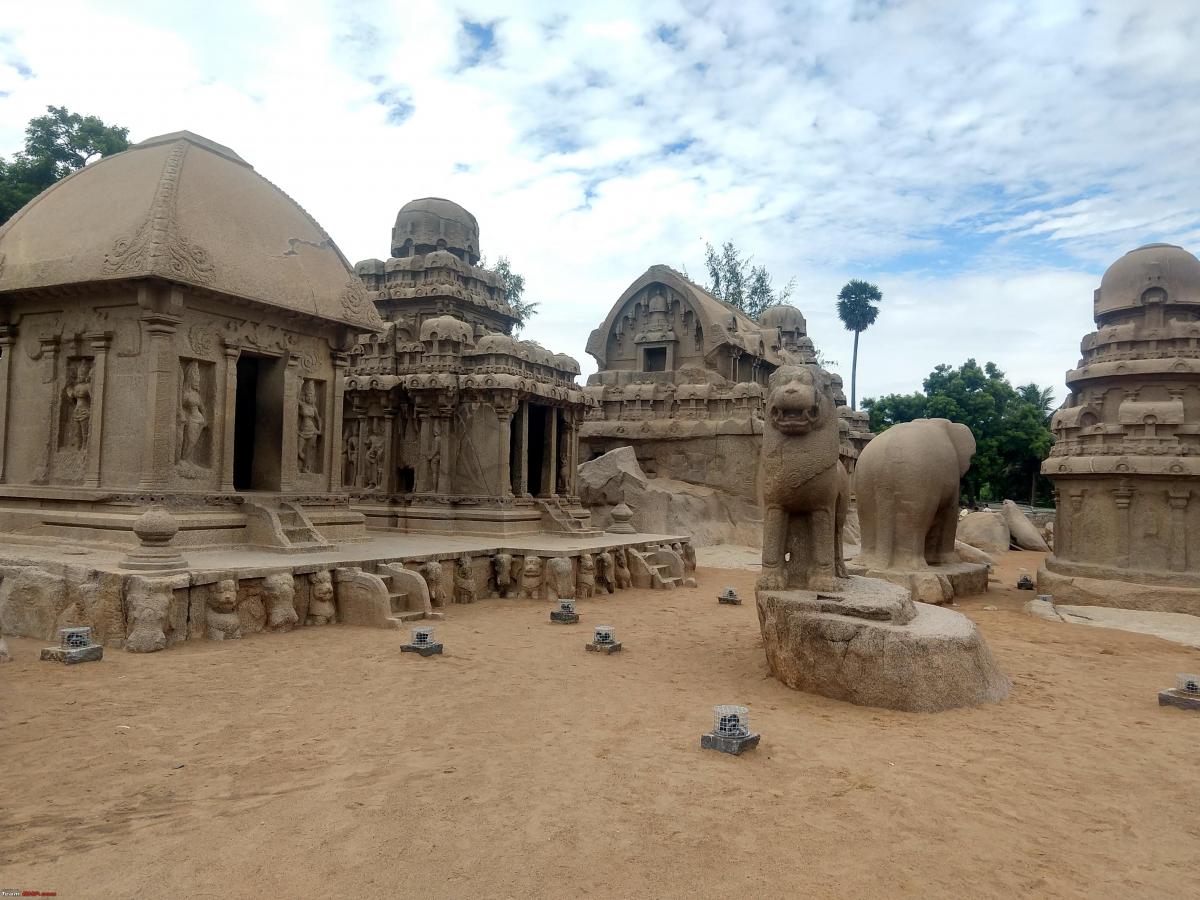
The Pancha Rathas (The Five Chariots)

Mahabalipuram Light House
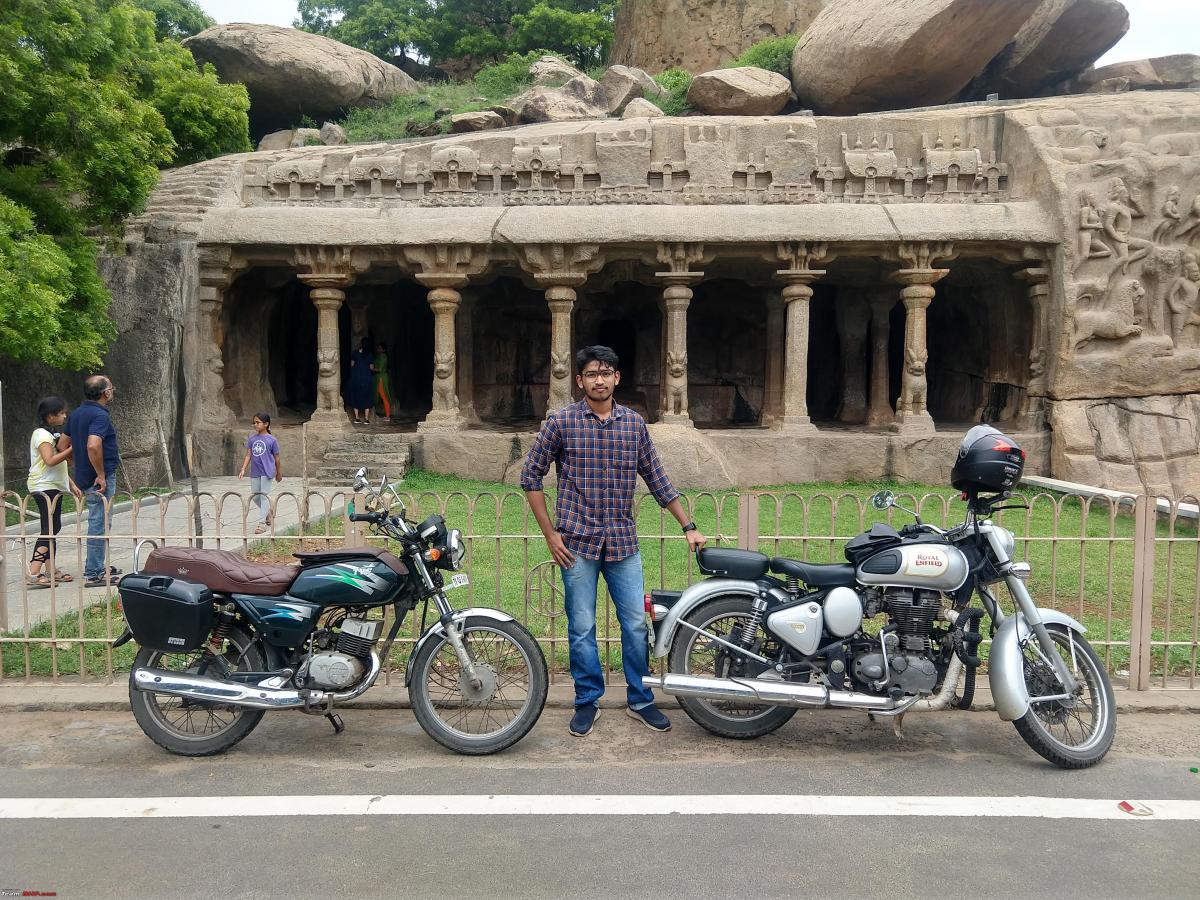
Krishna Mandapam
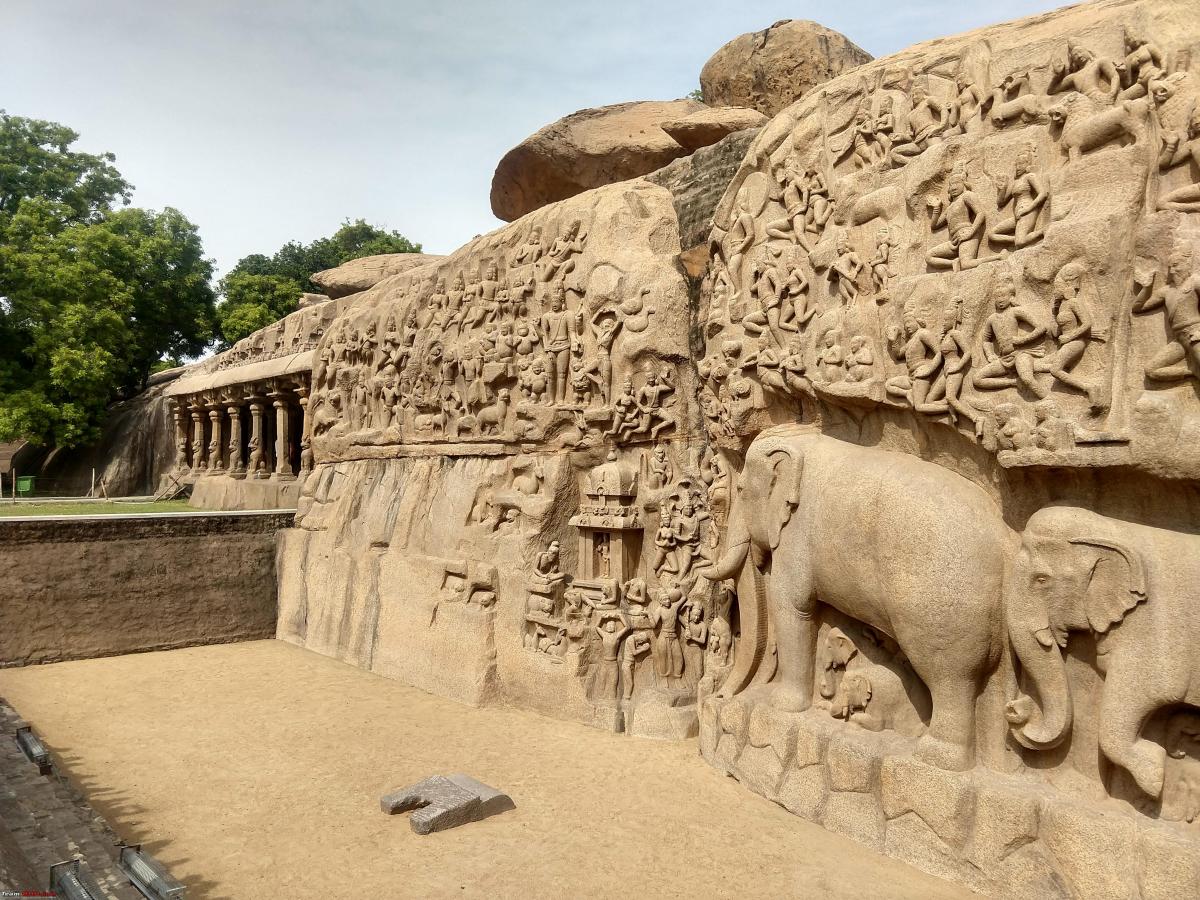
Descent of the Ganges, Arjuna’s Penance
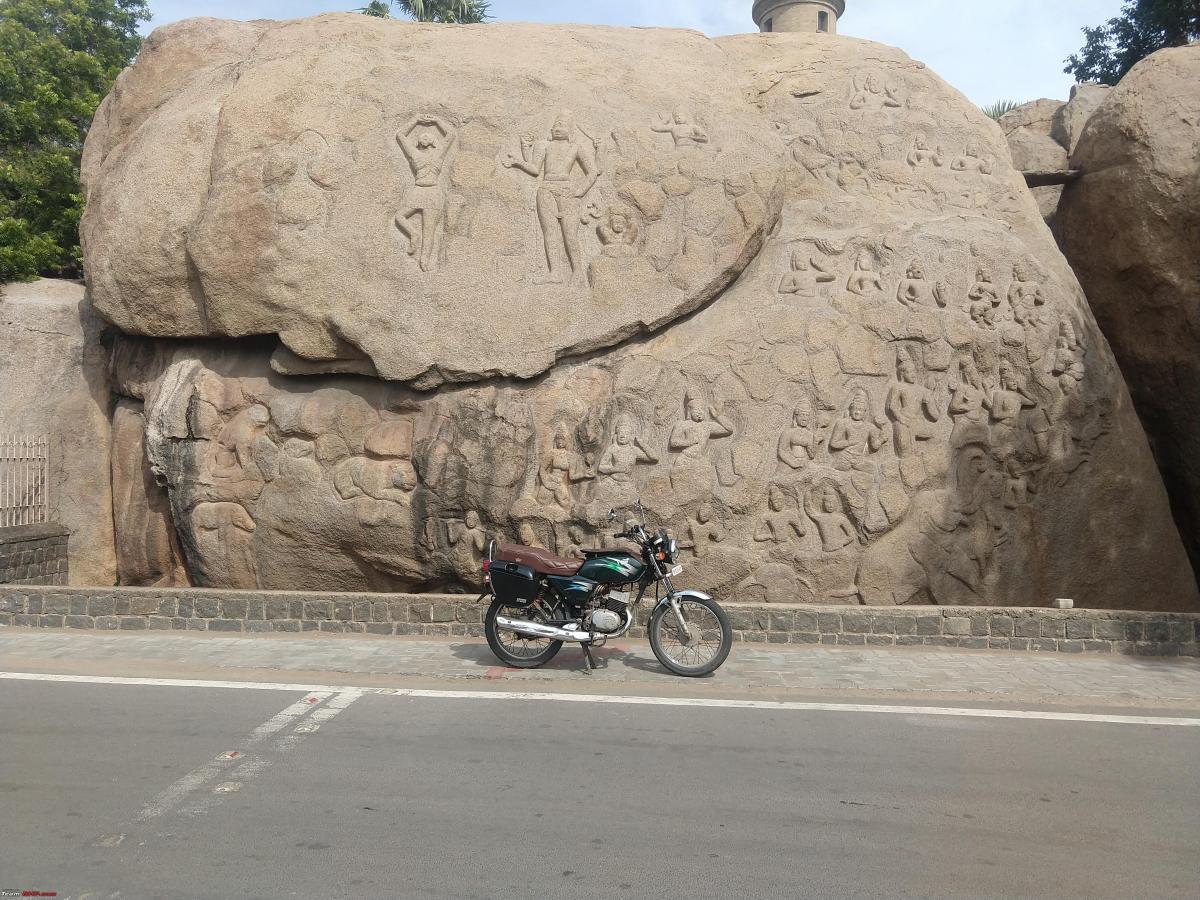
“Practise Panel near Arjuna’s Penance”, according to Wikipedia
“Wakey Wakey!” Let this not turn into a travelogue. I’ll do a proper travelogue thread later on!
While returning, I noticed she suddenly started behaving a bit erratically and there was a new jerkiness that would pop out randomly here and there. When I had a look at the carb, I understood why. I had accidentally loosened the air screw so much that it had popped out while on the journey and was now long gone. So, my bike was running without an air screw now.
Luckily, I still had my old original MikCarb carburettor with me at home. This one was a Ucal I had replaced it with since the original one started giving troubles that kept on resurfacing. We did manage to reach home on time as planned with no hiccups other than slightly jerky acceleration. Later that evening, I removed the air screw from the old carb and put it in the place of the missing air screw on the one on my bike. Then, I used a bootlace to tie the choke lever firmly in place the whole time to give my thumb a break. I rode my bike like this for a week or so till all the fuel got almost dry.
When I filled in fresh fuel and oil afterwards, the whole problem got solved. After a carb tune-up, she was back to how she had always used to be and was singing as sweetly as ever. Lesson learnt.
From then on, I changed my regular fuel station to another trustworthy one and always purchased my own 2T oil. Branded ones properly packed in sealed containers. The 500ml bottles. They are compact enough to be easily carried on both commutes and tours, but large enough in quantity to serve you for a lot of miles. I also found out that this route is in fact, cheaper in the long run as well. Not only that, but also you can purchase as many bottles as you’d need on a trip and carry them with you and never worry about the availability of 2T oil while you travel far. A true win-win.
If your fuel station offers branded 2T oil that is contained in sachets, then I suppose there’s no harm in that as well. But loose 2T oil is a no-no. Don’t ever risk it. Especially if you’re touring.
I’ll make an entire thread about 2T Oil including comprehensive tests of different kinds of 2T oil in the future.
When it comes to spares you have to carry with you on trips, there are only 4 that come to my mind when it comes to the Max 100. A spark plug, a clutch cable, a throttle cable, and a spare tube. Also, some basic tools like a spark plug spanner, a spanner set and a screwdriver. This will keep you safe on most journeys.
Spark plugs may be prone to fouling on 2T motorcycles, especially when we use higher quantities of oil. But this itself is highly rare and again is just like the oil pump. Mostly reliable, until it isn’t. Just carry a spare spark plug and a plug spanner with you just to be safe.
As for the clutch cable, these are prone to snapping with age and again, do it unexpectedly. My first experience of this happened recently while at a traffic light when I was returning home from college. The lights had gone green when I pulled in the clutch lever and engaged first gear when it simply snapped and the lever became free moving, stalling the engine. I knocked her back to neutral, got off and moved her to the side of the road. Fortunately, this happened just about 800 metres from my mechanic’s place. So, I walked her to my mechanic who replaced the cable at once. I have carried a spare one ever since. This also applies to the throttle cable. Mine hasn’t caused any issues yet, but always better to be safe than sorry, especially while touring when you may find it hard to find spares for older motorcycles like these.
As for the tube, I had to learn that the hard way as well. I was convoying with my friend who was on his motorcycle. We were going somewhere for a college project when a long and thin nail decided to puncture my rear tyre. I suddenly noticed the loss of pickup and speed and then felt this periodic wobbliness. Pulled over and saw the tyre had gone completely flat. Mind you, this is my bike with spoked wheels and tubed tyres. So, we rode very slowly at about 10 km/h till we, fortunately, found a puncture shop about 2 kilometres away and got the tube replaced rather than patched. If your motorcycle has alloys and tubeless tyres, then this may not apply, but for those who have classic spoked wheels, this most certainly does. Carry a spare tube with you just in case when on a tour. Never push your luck unnecessarily.
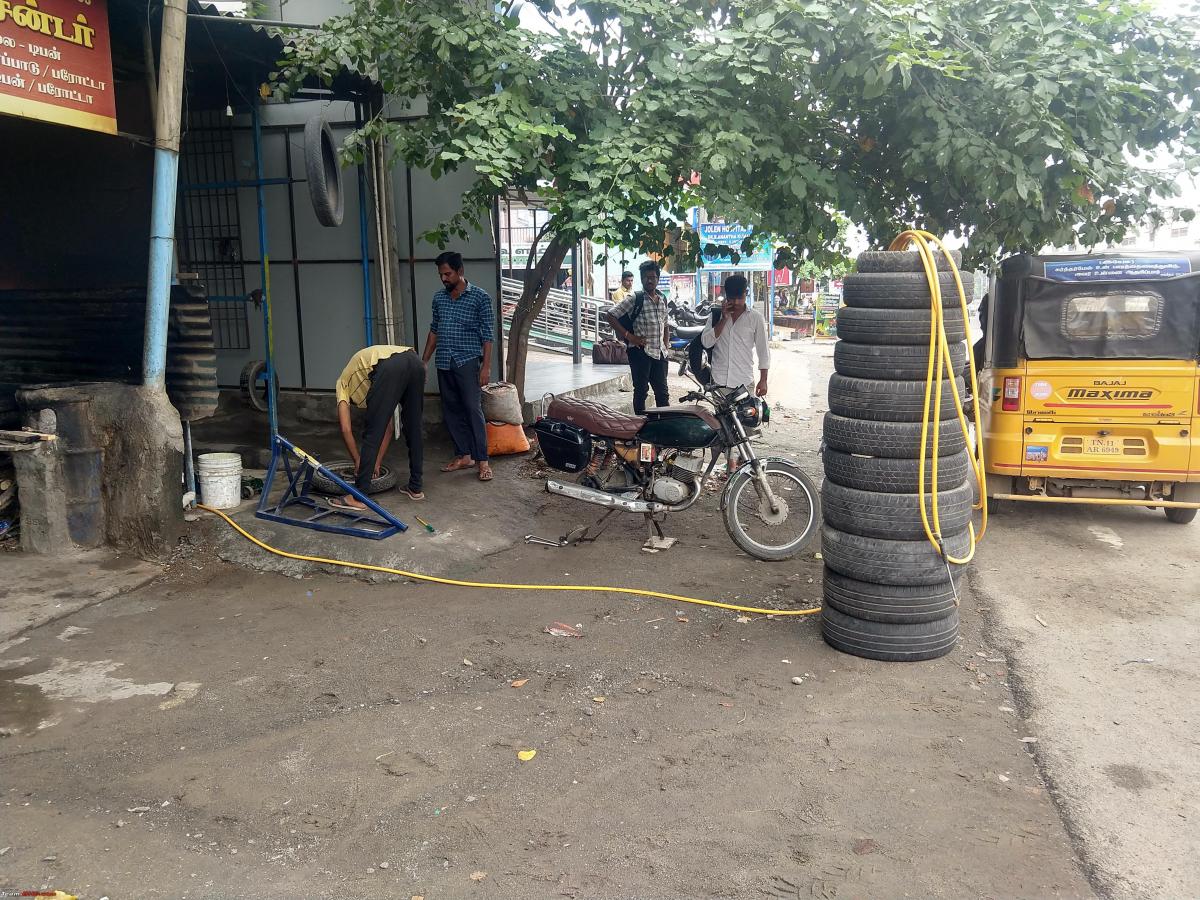
The first ever puncture.
Another item you can optionally carry are petrol pipes. I haven’t been doing it so far as the pipes are usually very reliable and rarely leak or require changing, but you can carry it along with some scissors to cut if if you want to.
Let’s talk about stability and rideability. The Max 100 has a single cradle chassis and a kerb weight of just under 100 kgs. It really is a featherweight. And of course, it’s a street motorcycle and a commuter with no fancy fairings or windshields. Just the essentials. And there’s this beautiful simplicity to it. Surprisingly enough, it’s fairly stable for what it is. In fact, it’s even more stable at an 80 kmph cruise on the highway than my uncle’s Honda CB Shine I learnt riding on. It’s a unique characteristic. Being light while also being reasonably stable. Of course, having a pillion does make it slightly more unwieldy, but nothing unmanageable really at all. It does have some vibes, but that is a result of my engine’s below-average condition. But even those are not that much to cause complaints at all. The mill is in general, a silky smooth and highly efficient unit for being a two-stroke and a twenty-year-old one at that.
The brakes are drums all around, but those are effective enough. I’ve never really felt they were inadequate in both the city and the highway. The back brake is the one that’ll be used most with the front brake pitching in as more of a stabilizer. The front brake on its own is admittedly quite weak though. I may upgrade the front to a disc setup in the future.
The lighting on the other hand is a Greek tragedy. I’ve heard many times on this forum itself that the Max 100’s beam used to be one of the best in its class at that time, I don’t know if it’s my bike, but if this was the best they had at that time, then that doesn’t really say much for the others. Not much of “lighting” then, eh? It’s not completely useless, but does only the bare minimum. This is one that desperately deserves an upgrade. Fortunately, there are upgrades and I look forward to them in the future.
Since this thread is also supposed to be about the functional and practical aspects of two-strokes, let’s talk about “Kitna Deti Hai?” While this question gets quite a bad rap among enthusiasts, I don’t think there’s anything wrong with it. In fact, I think it’s wise. When you’re riding or touring on an older motorcycle with no fuel gauge, you better know its mileage and range if you don’t want to get stranded. What’s more, knowing this helps you to budget your finances more effectively, especially when you ride so much. The answer to that question is, “Your mileage might vary”, depending on the condition of your motorcycle.
My bike gives me a very consistent 40 kmpl under the most aggressive riding conditions and gives 50 kmpl when ridden gently. These are city figures. Highway cruises generally give even more, but I haven’t properly measured it as of now. But during the last trip I took, the rough estimate is 55. But I won’t be surprised if it was even more. The Max 100, the AX 100 (The R version) and the Samurai (These three share the exact same mechanicals and engine port map) are in actuality, supposed to give anywhere between 55-65 kmpl in general if their condition is pristine and they’re well-tuned. Who said two-stroke has to mean inefficient? I don’t see much difference in what most modern commuters deliver compared to this. In fact, those are usually worse off as they age.
The Max 100 has a fuel tank capacity of 12 Litres, with 10 litres main and 2 litres reserve, giving me a realistic range of roughly 450 Kms minimum when the tank is about full, depending on the riding conditions and riding style. Not bad, I’d say. In fact, when I went to Pondicherry, I had done a full tank before going. After returning, I rode my bike for a full week on my daily commute just like that till it got over eventually. It's surprisingly efficient. And this was a trip with a pillion as well. It was a wonderful experience. Check it out if you haven’t.
Not just two-strokes, but all engines do well when given periodic breaks while riding. But since all road-going two-strokes ever sold in India are air-cooled and since two-stroke engines in general have more power strokes than four-strokes, they certainly do require breaks while on tours. My formula is simple. For every hour of touring, I ride for 50 minutes and take a break of 10 minutes. This is good for both the motorcycle as well as for us, as it reduces riding fatigue to the absolute bare minimum as in those 10 minutes, you have enough time for relaxing, walking about and having a good stretch. Trust me, keep doing this consistently while on long trips and both the engine and your body will be eternally grateful for it.
As for touring luggage setups, I’ll do an entire thread dedicated just to that. As for now, I haven’t really done a tour wherein my Studds side box hasn’t been sufficient. And my motorcycle is mostly bone stock with only a few cosmetic changes.
The next question when it comes to two-strokes leads us back to the second paragraph of this post. Namely, how environmentally friendly or unfriendly they are. Again, this deserves a separate thread of its own, but let me attach an extract of the results of my PUC (Pollution Under Control) Certificate and let you be the judge yourself. Mind you, my bike’s engine isn’t in particularly good condition, so if this is the case now, imagine the results if I get my engine properly re-worked.

This means re-registration and keeping it road-legal isn’t really a hassle as long as you take good care of your steed and never miss a single FC Test once every 5 years since the first expiry. While they have increased the rates, it still isn’t really that expensive to do and shouldn’t serve as a mental block for any enthusiast looking forwards to two-stroke ownership. In fact, I bought my bike in 2022 with the FC expired in 2017 itself (15 years from its original manufacturing and registration in 2002), and got her re-registered in March this year. If I, a college student on a tight budget could do it, I don’t see how anyone else couldn’t, as long as you’re truly an enthusiast and serious about the ownership journey.
Always keep the documents of your motorcycle with you while both commuting as well as touring. Keep them always updated. It makes more financial sense not to waste money on the small cumulative penalties for expired registration during the re-registration process. One of our duties as enthusiasts is not just to preserve our classic machines, but also to keep them road legal. Apart from the RC Book or Smart Card, you need your insurance copy, your driving license and a PUC Certificate. This ensures that in case you get pulled over by the traffic police, you can present your documents immediately and carry on with your journey with no trouble. It’s all for following the rules and having peace of mind, so you can focus on enjoying your adventures fully.
With that out of the way, let’s talk about one simple aspect of motorcycling in general. At the end of the day, it’s all about the bond we share with our bike. We want our bikes to be trustworthy and never give up on us. And two-strokes are like that. Their inherent simplicity blesses them with a surprising amount of reliability in relation to how old some of these machines can be. This is a healthy relationship one can have with one’s motorcycle. I mean no offence to some folks, but I notice how some enthusiasts romanticize their machine’s unreliability and temperaments, and although I truly do understand where all that comes from, I personally prefer trustworthiness, and that’s exactly what I have found so far in my little 100cc two-stroke built twenty years ago. The exact same age as me. The exact same year as my very own birth. 2002.

And that’s a truly special connection you don’t find all too easily. To this day, I never have a second thought when it comes to getting onto my machine and simply doing a 100-kilometre run just like that, completely unplanned. She absolutely always fires up with a roar on the second kick when cold and on the first kick when warmed up. That’s a quality I cherish in her and always count on, especially whenever we both travel outside the great old city, with lush, green delights welcoming us and the infinite vastness of the open sky edging us to keep moving forward on and on and on.
So, the final question. Why did I spend so much time writing down all of this at this period of history, and why would I spend even more time writing even more stuff related to all this in the upcoming future? Well, in simple words, it’s a compilation of my personal experiences to help those starting out, however few in number they may be. We all start out as newbies always and require whatever guidance and help that can be gotten to progress. I wouldn’t be where I am without the guidance I received from my friend while starting out as well as all the online sources that helped and encouraged me. This is my contribution to help out those new to this and to encourage the preservation of our beloved two-strokes and classic motor vehicles in general.
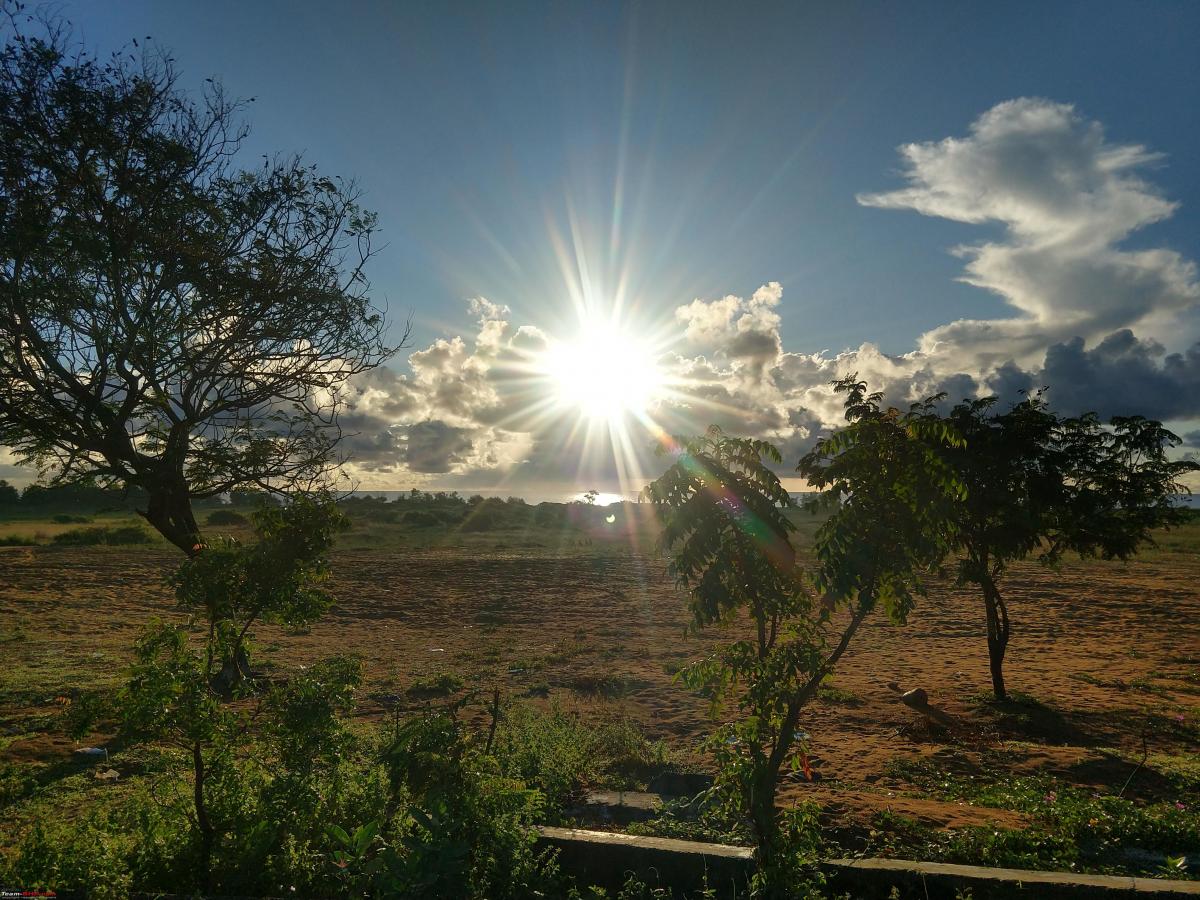
I humbly request all those reading this, especially our highly knowledgeable seniors, to pitch in with their experiences as well and suggest corrections or improvements wherever possible.
Thank you for reading. Hope this helps. And with that, it’s time to conclude what was an amazing year. Hope this new year brings you many new adventures to look forward to. Cheers and happy riding!
Check out BHPian comments for more insights and information.




